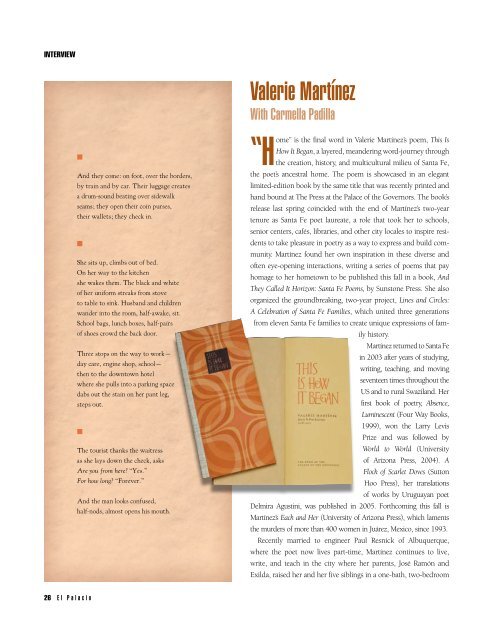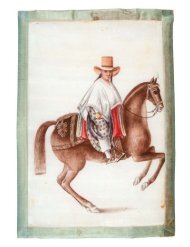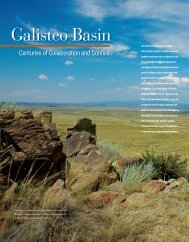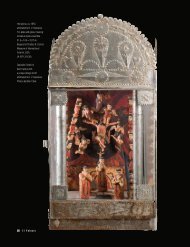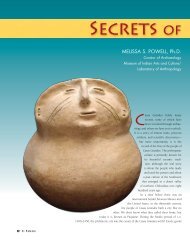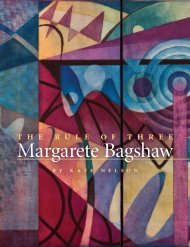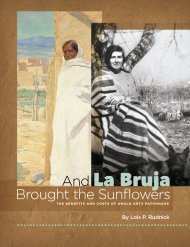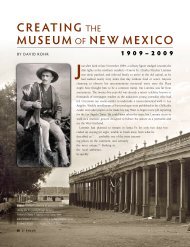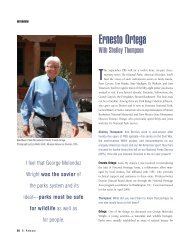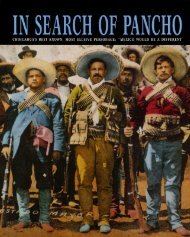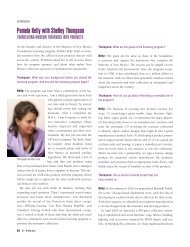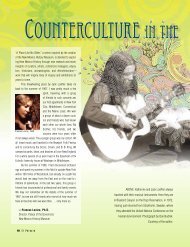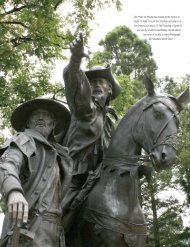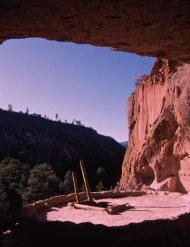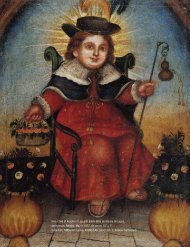Valerie Martínez - El Palacio Magazine
Valerie Martínez - El Palacio Magazine
Valerie Martínez - El Palacio Magazine
You also want an ePaper? Increase the reach of your titles
YUMPU automatically turns print PDFs into web optimized ePapers that Google loves.
INTERVIEW<br />
26 E l <strong>Palacio</strong><br />
<strong>Valerie</strong> <strong>Martínez</strong><br />
With Carmella Padilla<br />
is the final word in <strong>Valerie</strong> <strong>Martínez</strong>’s poem, This Is<br />
How It Began, a layered, meandering word-journey through<br />
“Home”<br />
the creation, history, and multicultural milieu of Santa Fe,<br />
the poet’s ancestral home. The poem is showcased in an elegant<br />
limited-edition book by the same title that was recently printed and<br />
hand bound at The Press at the Palace of the Governors. The book’s<br />
release last spring coincided with the end of <strong>Martínez</strong>’s two-year<br />
tenure as Santa Fe poet laureate, a role that took her to schools,<br />
senior centers, cafés, libraries, and other city locales to inspire residents<br />
to take pleasure in poetry as a way to express and build community.<br />
<strong>Martínez</strong> found her own inspiration in these diverse and<br />
often eye-opening interactions, writing a series of poems that pay<br />
homage to her hometown to be published this fall in a book, And<br />
They Called It Horizon: Santa Fe Poems, by Sunstone Press. She also<br />
organized the groundbreaking, two-year project, Lines and Circles:<br />
A Celebration of Santa Fe Families, which united three generations<br />
from eleven Santa Fe families to create unique expressions of family<br />
history.<br />
<strong>Martínez</strong> returned to Santa Fe<br />
in 2003 after years of studying,<br />
writing, teaching, and moving<br />
seventeen times throughout the<br />
US and to rural Swaziland. Her<br />
first book of poetry, Absence,<br />
Luminescent (Four Way Books,<br />
1999), won the Larry Levis<br />
Prize and was followed by<br />
World to World (University<br />
of Arizona Press, 2004). A<br />
Flock of Scarlet Doves (Sutton<br />
Hoo Press), her translations<br />
of works by Uruguayan poet<br />
Delmira Agustini, was published in 2005. Forthcoming this fall is<br />
<strong>Martínez</strong>’s Each and Her (University of Arizona Press), which laments<br />
the murders of more than 400 women in Juárez, Mexico, since 1993.<br />
Recently married to engineer Paul Resnick of Albuquerque,<br />
where the poet now lives part-time, <strong>Martínez</strong> continues to live,<br />
write, and teach in the city where her parents, José Ramón and<br />
Exilda, raised her and her five siblings in a one-bath, two-bedroom
<strong>Valerie</strong> <strong>Martínez</strong><br />
Photograph by<br />
Thomas Sayers <strong>El</strong>lis.<br />
Opposite:<br />
This Is How It<br />
Began, printed<br />
and bound at<br />
The Press at the Palace<br />
of the Governors.<br />
house on San Ildefonso Road. Carmella Padilla sat down with<br />
<strong>Martínez</strong> in a coffee shop not far from that home to talk about<br />
the cultural beauty and complexity of Santa Fe—a place where,<br />
as <strong>Martínez</strong>’s work so vividly conveys, you can go home again.<br />
Padilla: In This Is How It Began, you tell the story of Santa Fe from the<br />
time it was, as you write, “smaller than the eye’s dark pupil, smaller than the<br />
tiniest yellow idea of seed, and tinier.” Tell me how it began here for you.<br />
<strong>Martínez</strong>: That’s a hard question. My memories of growing up<br />
are of a beautiful family, a very loving family, but I had an early<br />
trauma at age seven, so I was also kind of wounded. When I<br />
turned thirteen, I turned to writing. But I think very fondly of<br />
my very busy, kind of chaotic family, and six children and school<br />
and sports and parents who were teachers. We participated in<br />
all of the Hispanic family rituals and funerals and gatherings.<br />
We belonged to the <strong>El</strong>k’s Club. It was kind of a tornado of a<br />
household growing up.<br />
Padilla: Had you not been involved in language or reading before thirteen?<br />
<strong>Martínez</strong>: My mother was an English teacher, but I don’t remember<br />
there being a lot of books around my house. I remember my<br />
dad used to love Reader’s Digest. But my parents were working.<br />
INTERVIEW<br />
My dad worked about four jobs; he left at six in the morning and<br />
came back at ten at night for us to all kneel down and say our<br />
prayers before bed. To earn a little extra money, my mom did<br />
various jobs. She sold Amway for a while, and she sold World<br />
Book encyclopedias. I do remember very vividly the two dictionary<br />
volumes, A through L and M through Z, and for whatever reason I<br />
decided to read those. I only made it to C, but I do remember that<br />
I would sit down in the evenings and read the dictionary.<br />
Padilla: You left Santa Fe after graduating from Santa Fe High School,<br />
first to attend Vassar College, then for many experiences. When you<br />
returned, were your perceptions of Santa Fe different?<br />
<strong>Martínez</strong>: There are positive ones and negative ones. To begin<br />
to understand what it is to live in one community all your life,<br />
like my parents do, and their friends, and many other families in<br />
Santa Fe, I really do feel like I’m understanding what it is to be<br />
committed to your community for all of your life. So that struck<br />
me. Also, the beauty of the landscape, which you just don’t<br />
appreciate when you’re younger. I moved so many places in the<br />
world and I loved so many landscapes. But when you actually<br />
stay in a community a long time, you really start feeling like<br />
this is the most beautiful landscape. You sort of grow into it and<br />
then it sort of grows onto you. You know how when you see a<br />
27 E l <strong>Palacio</strong>
INTERVIEW<br />
tree that actually looks like two trees that have somehow merged I think we have lots of work to do here in Santa Fe, but<br />
and are growing together? I feel like that’s happening to me, the really kind of beautiful work about grappling with our identity,<br />
longer I’m here, the landscape sort of embraces you, and you put about connecting across the boundaries that separate us, try-<br />
down roots. But I’m also disturbed by things in Santa Fe.<br />
ing to figure out how a new generation celebrates its sense of<br />
self. The city’s 400th anniversary was a good way for us to say,<br />
Padilla: Why?<br />
“OK, there’s 400, and it was contentious and difficult, but now<br />
<strong>Martínez</strong>: When we were growing up in Santa Fe, everybody<br />
what? What’s going to happen in the next 400 years?”<br />
lived in all the neighborhoods, they got along or they didn’t get<br />
along, but they were mixed. There are some neighborhoods in<br />
Santa Fe that are fairly mixed, but there’s more segregation—<br />
racial, socioeconomic—than I ever remember, that I think<br />
makes it harder for Santa Feans to connect.<br />
Once I had an Anglo woman turn to me and say, “You’re the only<br />
Padilla: I was reading your contributions to the collaborative online dialogue,<br />
“LaChiPo,” which seeks to “encourage an aesthetic that resides within, rises<br />
from, and reshapes a particular community while rejecting the colonial narrative.”<br />
Coming from Santa Fe, which promotes its Spanish colonial roots in<br />
such a big way, do you feel that the colonial narrative here can be reshaped?<br />
Hispanic person in this town that I socialize<br />
<strong>Martínez</strong>: Yeah, and I think the way we do it is we offer our hand<br />
with,” and it’s not like she was at all happy<br />
out and take the hands of the Pueblo people and the other Native<br />
with that, and I realized that other people<br />
people that live here. That’s the only way we are going to be able<br />
have similar feelings. A lot of times locals<br />
to articulate our own history in a way that encompasses its com-<br />
say, “I go to this restaurant, and there’s not<br />
plexity and encourages us to move beyond<br />
even one Hispanic person there, so I won’t<br />
the blacks and whites. What the Spaniards<br />
go back.” So you’ve got this interesting mix<br />
Photograph by did—I have to admit it’s in my blood—was<br />
of people who come here, many of them<br />
Alejandro Uva.<br />
absolutely devastating and destructive, it<br />
because it seems diverse, but they are still not <strong>Valerie</strong> <strong>Martínez</strong> will read her poetry and made for the destruction of whole tribes.<br />
meeting people who have lived here all their sign books as part of the Third Annual That is the truth, and the truth is also that<br />
lives. I don’t think that’s going to happen so New Mexico Women Authors’ Book this place exists because of the Spanish<br />
naturally now, unless your social circle is Festival on Saturday, October 2, at people. Maybe they should have stayed<br />
already very diverse. I think it’s not just going 12:20 pm in the Meem Community Room home, but they didn’t, and now we have to<br />
to change tomorrow, that we need to step at the New Mexico History Museum. acknowledge that.<br />
away from these invisible boundaries. I think The festival runs through October 3 in In the eighties, I had a class with N. Scott<br />
we have work to do.<br />
various locations at the History Museum Momaday at the University of Arizona, and<br />
and under tents in the Courtyard of we were reading his book The Way to Rainy<br />
Padilla: Is that part of why you wanted to be<br />
poet laureate?<br />
the Palace of the Governors. Over 100<br />
authors will present seminars for writers<br />
and readings for the general public.<br />
Mountain, and on the back of the book it<br />
said, “This book nags at the white man’s<br />
conscience.” A young white woman in our<br />
<strong>Martínez</strong>: If they choose you, you have this The festival is part of the “New Mexico class stood up and she was very angry about<br />
opportunity to do a community project. Creates” program of the Museum of New this, and she said, “I am so tired of being<br />
For the Lines and Circles project, I wanted Mexico Foundation Museum Shops, made to feel guilty about what my ancestors<br />
to get some families to meet and know each showcasing the work of New Mexico did that I don’t agree with. I wasn’t part of<br />
other over two years. My goal was that each artists. Music, food, and special pre- it, I don’t agree with it, and I’m really tired<br />
family had to have at least three generations sentations from the Palace Print Shop, of this.” What ensued was this really inter-<br />
living in the city because, to me, whether Santa Fe’s Book Arts Group, and the Fray esting conversation because the class was<br />
you’ve been here 400 years or 10 years, if Angélico Chávez Library will contribute very mixed with Native students, Hispanic<br />
you have three generations, I thought that’s to an inspiring celebration<br />
students, black students, white students. At<br />
enough of a commitment to this place. of women’s writing in New Mexico. the end, a Navajo woman raised her hand,<br />
The community got to see that this or that For more information, visit<br />
and she said, and I’m just paraphrasing her,<br />
family doesn’t exactly fit into the tricultural newmexicocreates.org.<br />
“Do you want to know what Native people<br />
conception of Santa Fe that gets promoted.<br />
want white people to say about this? I think<br />
28 E l <strong>Palacio</strong>
it’s kind of simple. We want you to acknowledge what happened,<br />
we want you to say that you’re sorry, we want you to not disconnect<br />
from your ancestors because in our conception it’s simply<br />
impossible to do that, and then we want you to walk forward.”<br />
I always remember that. So that dialogue has to be informed<br />
in conversations with the people who were almost destroyed.<br />
Otherwise, how do we reshape the way we talk about history?<br />
I really think we need this in Santa Fe because so much of the<br />
racial tension has to do with the way things are articulated.<br />
Padilla: In writing about the Lines and Circles project, you say that the<br />
people of Santa Fe, “those that are here to stay,” are the city’s richest<br />
asset. Are you referring mostly to natives of Santa Fe? Where do you<br />
see the newcomer fitting in?<br />
<strong>Martínez</strong>: I have a problem, actually, with the kind of one-upsmanship<br />
that we hear a lot in Santa Fe, the “Oh, my family’s been<br />
here 400 years” kind of conversation. I mean, my family has been<br />
here for that long, but that does not make me more committed to<br />
this place or to its welfare or to its people.<br />
In the Lines and Circles project, one family has been here ten<br />
years, and they have three generations, and if you hear them talk<br />
about Santa Fe, they are as devoted as anyone to the present and<br />
future, and they grapple with the past. The asset of the people who<br />
are here to stay is that they see all the city’s strengths and weaknesses<br />
and they want to stay with it. Some of those families have<br />
been here forever and some are newcomers. My dad’s ancestors<br />
came in 1598, my mother’s in 1630, and even though that’s a long<br />
time, we are immigrants. So the whole, “I’m a native” thing, I really<br />
don’t feel anyone can use that term unless you really are a Native<br />
person. The future is who is committed to staying here. That’s<br />
where we link our elbows.<br />
Padilla: On that note, I love this stanza in This Is How It Began:<br />
The tourist thanks the waitress<br />
As she lays down the check, asks<br />
Are you from here? “Yes.”<br />
For how long? “Forever.”<br />
So, who is this woman?<br />
<strong>Martínez</strong>: “Forever” could mean she was born and raised here, so<br />
she could be white, she could be Hispanic, but in my mind’s eye,<br />
she is a Native woman or a Pueblo woman. I created the phrase<br />
because, if you were born here and have lived here forever, it’s<br />
becoming an unusual phenomenon because most people are so<br />
mobile. So to be able to say, “I was actually born here and am still<br />
working here” is a true statement of forever.<br />
This poem has four languages—English, Spanish, Navajo,<br />
and Tewa—so the poem, I hope, is inclusive of the cultures<br />
it celebrates. One of the challenges of this poem was I had<br />
to deal with the whole history of New Mexico. There are<br />
passages in the middle that try to grapple poetically with the<br />
bloody history of this place, and that was very hard.<br />
Padilla: But you do that so well. For example, the line “Benevolent<br />
place, place of destruction.” That says so much.<br />
<strong>Martínez</strong>: One of the more powerful images for me, emotionally,<br />
is in one of the stanzas about conquest, destruction, war, where<br />
they have to leave the dead where they are. They can’t always<br />
bury them, and the animals take them into their mouths, so the<br />
dead get taken into the creatures of this place, so even the creatures<br />
contain the history. That is a very dark and violent image,<br />
but it’s also my way to try to talk poetically, metaphorically, about<br />
history. When we get to the Santa Fe Trail, or to the waitress at<br />
the end, it gets very literal. There’s a family getting ready to go to<br />
work and school, there’s a woman who works at the downtown<br />
hotel. I wanted to finish the poem to honor the real people of all<br />
backgrounds who work here and live here.<br />
Padilla: In your essay “Diversity, Understanding and Reconciliation<br />
in Santa Fe” you write, “I feel the force of history upon me. . . .<br />
I feel embarrassed when I answer a Spanish-speaking native in my<br />
half-fluent Spanish.” I can completely relate to that. How do you feel<br />
about the loss of language between our generation and our parents’<br />
generation?<br />
<strong>Martínez</strong>: It’s a huge loss. It is something that my generation<br />
struggles with; it somehow makes me feel I failed my own<br />
family and culture. Young Latino poets and writers are grappling<br />
with all these issues very much right now because we have every<br />
kind of Latino poetry being written, from experimental to autobiographical<br />
narrative. And they’re all struggling with fluency or<br />
lack of fluency in Spanish, and whether we have to write about<br />
topical themes about being Latino. There are people who will say<br />
that once you stop writing about your culture, or using Spanish<br />
language, then you’re no longer Latino. I actually reject that.<br />
Padilla: Do you identify yourself as a Latina poet? A feminist poet?<br />
<strong>Martínez</strong>: I just say that I’m a person of color because all those<br />
terms are complicated for me. I’m a poet who is a feminist and<br />
who cares about women’s issues. But at the heart of it, I’m a poet.<br />
That’s my core.
Padilla: Would you say that poetry healed you?<br />
<strong>Martínez</strong>: Oh, yeah, it saved my life. When I was young, it helped<br />
me emotionally deal, it was a way for me to have a voice, it gave<br />
me a place in the world. It still does. I love poetry. I want so badly<br />
for poetry not to become obsolete. To have fewer and fewer<br />
readers of poetry each year, this really disturbs me. I’ll do anything<br />
to bring poetry to communities because it’s a different kind<br />
of language. It’s not the language of direction, it’s the language of<br />
indirection. We have plenty of language in our culture that gets<br />
at things directly. Poetry preserves a place in language where you<br />
can meander, where you can be circular, where you can get at<br />
things in a different way.<br />
Poetry forces you to stop. It slows you down. I say this to my<br />
students all the time: I don’t want poetry to become a language of<br />
consumption, something that you can just eat and swallow like<br />
you do with your French fries before you leave the parking lot.<br />
Even with this long poem, you don’t have to sit down and read<br />
all the sections at once. A poet doesn’t want you to do that, I don’t<br />
want you to actually get to the end of this poem. To have someone<br />
spend fifteen minutes on four lines, that’s a really beautiful<br />
thing. That means somebody is honoring language.<br />
Padilla: Do you see yourself being in Santa Fe forever?<br />
<strong>Martínez</strong>: Oh, yeah, I’m not going anywhere. I’m sort of stuck<br />
now, sort of sunk in for the long haul. I think there’s a yearning<br />
once you root yourself in a home somewhere. You want to<br />
go back to that. I feel like that about the landscape. I yearn for<br />
the open sky, like people yearn for the ocean.<br />
Padilla: It’s significant that the last word in your poem is “Home.” In<br />
every way, it’s the final word.<br />
<strong>Martínez</strong>: Yeah, well, the poem is for everyone who lives here.<br />
There are people who, this has been their home much longer than<br />
mine, so multiply what I just said about yearning by all their years<br />
and days. The poem is mine but it also tries to imagine how other<br />
people feel about this place. It comes from two years of talking to<br />
people about what this place means to them. It’s been informed by<br />
everybody who lives here and how much they love this place. n<br />
This Is How It Began is available in a hand-bound, limited edition for $100 from<br />
The Press at the Palace of the Governors, 505-476-5096 or thomas.leech@state.nm.us.<br />
<strong>Valerie</strong> <strong>Martínez</strong>'s website is www.valeriemartinez.net.<br />
Carmella Padilla is a contributor to <strong>El</strong> <strong>Palacio</strong> and the author of several books,<br />
including <strong>El</strong> Rancho de las Golondrinas: Living History in New Mexico’s La Ciénega<br />
Valley, published by the Museum of New Mexico Press.


